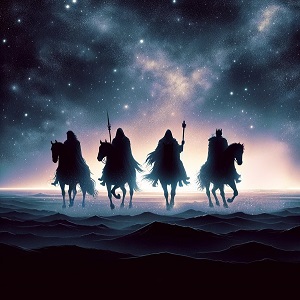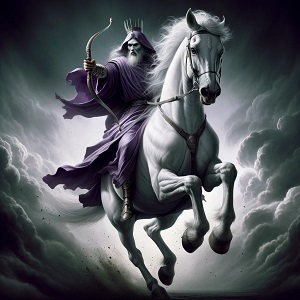
The Four Horsemen of the Apocalypse
The Four Horsemen of the Apocalypse, as depicted in the Book of Revelation, represent a deeply symbolic and prophetic vision that has captivated scholars, theologians, and artists throughout the ages. This imagery, rich in metaphor and allegory, serves as a cornerstone for eschatological discussions within Christian theology.

The White Horse
Scriptural Foundation: And I saw, and behold a white horse: and he that sat on him had a bow; and a crown was given unto him: and he went forth conquering, and to conquer.
Revelation 6:2
Linguistic Insight: The term crown is translated from the Greek stephanos, traditionally signifying a victor's garland, as opposed to diadema, which denotes a sovereign's crown. This distinction hints at a form of conquest achieved through victory in contest rather than by royal decree or inheritance.
Theological Interpretation: The rider of the white horse has been the subject of much debate. Some exegeses align this figure with Christ, particularly due to the parallel of Christ's return on a white horse in Revelation 19:11 . This interpretation views the rider as a harbinger of spiritual conquest and the spread of the gospel. Conversely, an alternate reading suggests this figure symbolizes the Antichrist or a deceptive peace, pointing to the bow (often seen as a symbol of distant warfare or deceit) and the lack of arrows, which could imply a conquest that is not forthright but rather achieved through subterfuge or diplomacy.

The Red Horse
Scriptural Foundation: And there went out another horse that was red: and power was given to him that sat thereon to take peace from the earth, and that they should kill one another: and there was given unto him a great sword.
Revelation 6:4
Linguistic Insight: The Greek pyrros, translating to red, evokes the imagery of fire and blood, suggesting violence, warfare, and bloodshed. This vivid depiction underscores the chaotic and destructive nature of this horseman's role.
Theological Interpretation: In examining the red horse and its rider, it's beneficial to consider potential parallels within the broader biblical corpus, such as Zechariah 1:8 , which describes,
I saw by night, and behold a man riding upon a red horse, and he stood among the myrtle trees that were in the bottom; and behind him were there red horses, speckled, and white.
This imagery may complement the interpretation of the red horse in Revelation by providing a precedent for symbolic color usage in prophetic visions, particularly concerning horses. In Zechariah, the horses are part of a vision that conveys divine surveillance and judgment upon the earth, which can be seen as analogous to the role of the red horse in Revelation, signifying divine judgment in the form of war. Thus, when considering the red horse of Revelation 6:4 , its association with war might also be interpreted within the context of divine oversight and judgment, as suggested by Zechariah's vision. The red horse's role in taking peace from the earth can be seen not merely as the unleashing of human conflict but as a manifestation of divine judgment, allowing warfare as a means to execute divine will and purify or test humanity. This perspective adds a layer of theological depth to the interpretation of the red horse, situating it within a broader biblical narrative of divine sovereignty over human history and the use of conflict as a tool for divine purposes.

The Black Horse
Scriptural Foundation: And when he had opened the third seal, I heard the third beast say, Come and see. And I beheld, and lo a black horse; and he that sat on him had a pair of balances in his hand. And I heard a voice in the midst of the four beasts say, A measure of wheat for a penny, and three measures of barley for a penny; and see thou hurt not the oil and the wine.
Revelation 6:5-6
Linguistic Insight: The pair of balances is rendered from zygos, suggesting a mechanism for weighing and apportioning, which can be symbolic of justice or, in this context, the rationing of resources.
Theological Interpretation: The black horse is commonly associated with famine. The imagery of balances or scales typically symbolizes the careful measurement of goods, reflecting scarcity, inflation, and economic distress. This interpretation is further supported by subsequent verses detailing the cost of basic foodstuffs, painting a picture of a time when sustenance becomes a precious commodity, leading to widespread suffering.

The Pale Horse
Scriptural Foundation: And I looked, and behold a pale horse: and his name that sat on him was Death, and Hell followed with him. And power was given unto them over the fourth part of the earth, to kill with sword, and with hunger, and with death, and with the beasts of the earth.
Revelation 6:8
Linguistic Insight: The term pale is derived from chloros, which can also connote a sickly green or yellow hue, reminiscent of decay or disease. This color choice further amplifies the morbid role of this horseman.
Theological Interpretation: This horseman unequivocally symbolizes death, with the explicit mention of Hell (or Hades) following implies an aftermath of the other horsemen's actions. The diverse means of death mentioned—warfare, famine, pestilence, and wild beasts—illustrate the multifaceted nature of the calamities that characterize the end times, underscoring the pervasive and inescapable reach of mortality. The phrase to kill with death as part of the description of the pale horse's rider is an intriguing and somewhat perplexing element of the passage. In biblical prophecy, repetition and the use of various terms to describe similar or related concepts often serve to emphasize the severity or multifaceted nature of a situation. The term death in this context is likely used to encapsulate a range of fatal outcomes that are not specifically war (sword) or famine (hunger) but are nonetheless lethal. This could include pestilence, plagues, diseases, or other forms of death that don't fall neatly into the categories of warfare or starvation. The use of death in this list may serve to highlight the comprehensive dominion of this horseman over all forms of mortality. It underscores the inevitability and universality of death as a consequence of the cumulative effects of the other horsemen's actions—war, famine, and the broader breakdown of the natural and social order leading to death in various forms. Furthermore, the mention of Hell followed with him reinforces the finality and eternal consequences of the actions of the pale horse's rider, linking temporal death with eternal judgment. This connection between physical death and spiritual destiny is a recurring theme in Christian eschatology, emphasizing the eternal significance of earthly events and the ultimate sovereignty of God over life and death. Thus, kill with death can be understood as a poetic way to convey the absolute and all-encompassing power of this horseman over human mortality, transcending the mere act of killing to encompass the full breadth and depth of death in its various forms and implications.
The Four Horsemen of the Apocalypse, as depicted in Revelation 6 , encapsulate the themes of conquest, war, famine, and death. These figures serve as profound metaphors for the trials and tribulations that precede the eschaton, mirroring the prophetic teachings of Jesus in the Olivet Discourse . In the Gospels, particularly in Matthew 24, Mark 13, and Luke 21 , Jesus outlines a series of events that will signal the approach of the end times, including false messiahs, wars and rumors of wars, famines, and pestilences in various places. These predictions closely parallel the symbolism of the horsemen, suggesting a continuity of apocalyptic themes within the New Testament.
The first horseman, symbolizing conquest, can be seen in the warnings against false messiahs and prophets who deceive many, as described in the Olivet Discourse. The second horseman, representing war, directly corresponds to Jesus' prediction of wars and rumors of wars and nation rising against nation. The third horseman, embodying famine, reflects the famines and earthquakes in various places that Jesus mentions. Lastly, the fourth horseman, denoting death through various means, can be associated with the pestilences and the increased mortality that Jesus foretells.
These parallels highlight the multifaceted nature of biblical prophecy, where themes of divine judgment and the impermanence of the current world order recur throughout. The alignment of the Four Horsemen with the Olivet Discourse emphasizes the consistent message across different parts of the New Testament about the challenges and upheavals that will mark the end times. This intertextual connection invites a deeper exploration of eschatological narratives, underscoring the complex interplay between divine justice and human history within the Christian theological framework, and encouraging believers to discernment and perseverance in the face of coming trials.